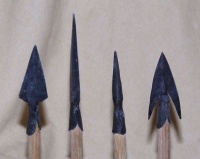Arrowhead: Difference between revisions
From Cunnan
Jump to navigationJump to search
No edit summary |
(categorising) |
||
| (One intermediate revision by the same user not shown) | |||
| Line 1: | Line 1: | ||
'''Arrow heads''' are the sharpened tips of [[arrow]]s. In modern terminology they might be called ''points''. |
[[image:arrowheads.jpg|right|200px|thumb|Replica arrow heads.]]'''Arrow heads''' are the sharpened tips of [[arrow]]s. In modern terminology they might be called ''points''. |
||
In prehistory they might be simply fire hardened point of the [[shaft]] itself or might be made of [[stone]]. [[Metal]] [[head]]s replaced these and might be of a number of varying types. The end of the head that joins the [[shaft]] might be [[tang]]ed (such as is found on typical [[Viking]] Age [[arrow]]s or many Eastern arrows) or [[socket]]ed as found on later medieval arrow heads and most modern points. |
In prehistory they might be simply fire hardened point of the [[shaft]] itself or might be made of [[stone]]. [[Metal]] [[head]]s replaced these and might be of a number of varying types. The end of the head that joins the [[shaft]] might be [[tang]]ed (such as is found on typical [[Viking]] Age [[arrow]]s or many Eastern arrows) or [[socket]]ed as found on later medieval arrow heads and most modern points. |
||
| Line 6: | Line 6: | ||
[[category:weapon parts]] |
[[category:weapon parts]] |
||
[[category:archery]] |
|||
Latest revision as of 22:29, 16 May 2006
Arrow heads are the sharpened tips of arrows. In modern terminology they might be called points.
In prehistory they might be simply fire hardened point of the shaft itself or might be made of stone. Metal heads replaced these and might be of a number of varying types. The end of the head that joins the shaft might be tanged (such as is found on typical Viking Age arrows or many Eastern arrows) or socketed as found on later medieval arrow heads and most modern points.
Tanged arrows have a greater tendancy to split the shaft when they strike the target than socketed arrows.
